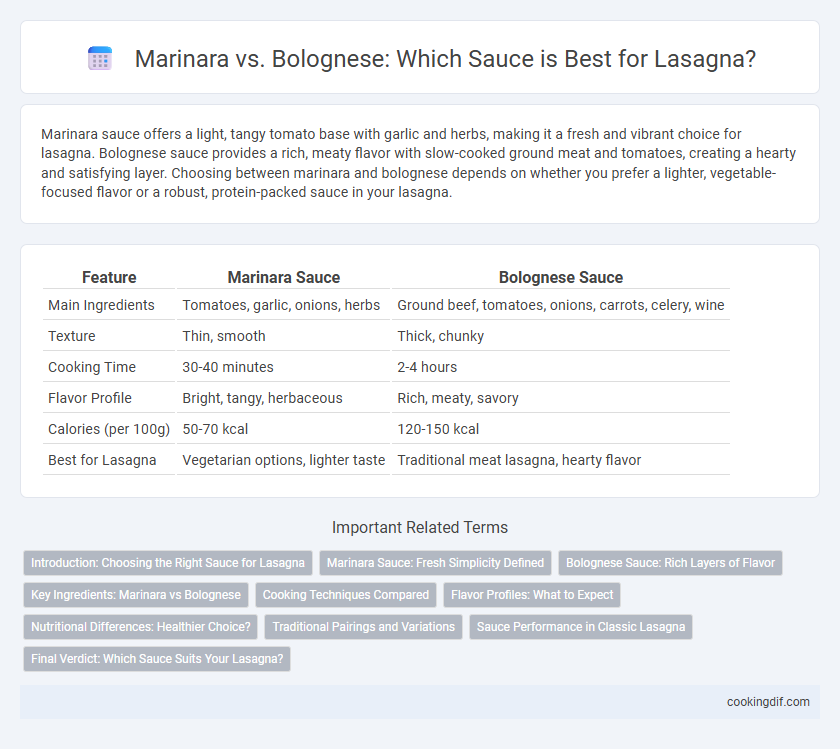Marinara sauce offers a light, tangy tomato base with garlic and herbs, making it a fresh and vibrant choice for lasagna. Bolognese sauce provides a rich, meaty flavor with slow-cooked ground meat and tomatoes, creating a hearty and satisfying layer. Choosing between marinara and bolognese depends on whether you prefer a lighter, vegetable-focused flavor or a robust, protein-packed sauce in your lasagna.
Table of Comparison
| Feature | Marinara Sauce | Bolognese Sauce |
|---|---|---|
| Main Ingredients | Tomatoes, garlic, onions, herbs | Ground beef, tomatoes, onions, carrots, celery, wine |
| Texture | Thin, smooth | Thick, chunky |
| Cooking Time | 30-40 minutes | 2-4 hours |
| Flavor Profile | Bright, tangy, herbaceous | Rich, meaty, savory |
| Calories (per 100g) | 50-70 kcal | 120-150 kcal |
| Best for Lasagna | Vegetarian options, lighter taste | Traditional meat lasagna, hearty flavor |
Introduction: Choosing the Right Sauce for Lasagna
Marinara sauce, a tangy tomato-based blend with garlic, herbs, and onions, offers a lighter, vegetarian-friendly option that highlights fresh flavors in lasagna. Bolognese sauce, made from slow-cooked ground meat, tomatoes, and aromatic vegetables, provides a rich, hearty depth that complements the layered pasta and cheese. Selecting between marinara and Bolognese depends on desired flavor intensity and dietary preferences, influencing the lasagna's overall texture and taste profile.
Marinara Sauce: Fresh Simplicity Defined
Marinara sauce embodies fresh simplicity with its vibrant blend of ripe tomatoes, garlic, olive oil, and basil, creating a light, flavorful base ideal for classic lasagna. Unlike the rich, meat-heavy Bolognese that simmers for hours, marinara offers a quick-cooked, herbaceous profile that enhances the layers without overpowering. This tomato-forward sauce highlights natural sweetness and acidity, making it a perfect choice for those seeking a bright, vegetarian-friendly lasagna experience.
Bolognese Sauce: Rich Layers of Flavor
Bolognese sauce offers a rich, savory depth with slow-cooked ground meat, tomatoes, onions, and garlic, creating an indulgent base for lasagna. Its complex layers of flavor come from simmering fresh herbs, red wine, and a touch of cream, distinguishing it from the simpler, tangier marinara sauce. This hearty meat sauce perfectly complements the pasta layers and creamy bechamel, elevating lasagna to a filling, gourmet experience.
Key Ingredients: Marinara vs Bolognese
Marinara sauce features key ingredients such as tomatoes, garlic, onions, and fresh herbs like basil and oregano, providing a light and tangy flavor profile. Bolognese sauce combines ground meat, typically beef and pork, with tomatoes, onions, carrots, celery, and a splash of red wine, resulting in a rich and hearty texture. The contrast of Marinara's simplicity and Bolognese's meat-based depth highlights distinct culinary roles in traditional lasagna recipes.
Cooking Techniques Compared
Marinara sauce requires a quick saute of garlic and onions in olive oil followed by simmering crushed tomatoes with herbs, emphasizing freshness and simplicity for a vibrant flavor. Bolognese sauce involves a slow, extended cooking process where ground meat is browned and then simmered with a soffritto base, tomatoes, wine, and milk, resulting in a rich, deeply layered taste. The key difference lies in cooking time and technique: marinara highlights bright, acidic notes through rapid simmering, while Bolognese develops umami complexity through slow braising and emulsification of fats.
Flavor Profiles: What to Expect
Marinara sauce offers a vibrant, tangy flavor with pronounced notes of garlic, herbs, and ripe tomatoes, creating a fresh and zesty base for lasagna. Bolognese sauce delivers a rich, savory taste characterized by slow-cooked ground meat, tomatoes, and aromatic vegetables, resulting in a hearty and deeply satisfying profile. Choosing between the two depends on whether you prefer a lighter, tomato-forward sauce or a robust, meaty complement to your layers.
Nutritional Differences: Healthier Choice?
Marinara sauce, primarily made from tomatoes, garlic, and herbs, is lower in calories and fat compared to Bolognese, which contains ground meat and dairy products, resulting in higher protein but also increased saturated fat and cholesterol. The antioxidants and vitamins like lycopene in marinara contribute to cardiovascular health, making it a lighter, heart-friendly option. Bolognese offers more iron and vitamin B12 due to the meat content, but its richness and calorie density may not be ideal for those seeking a low-fat, low-calorie lasagna sauce.
Traditional Pairings and Variations
Traditional pairings for lasagna often feature marinara sauce, a vibrant tomato-based sauce with garlic, onions, and herbs that complements vegetarian versions and lighter layers of cheese and vegetables. Bolognese, a rich meat sauce made with ground beef, pork, and sometimes veal, mixed with tomatoes and red wine, is favored in classic Italian lasagna alla Bolognese, providing depth and hearty flavor. Variations may blend the two sauces or use bechamel in combination with Bolognese to create a creamy texture characteristic of authentic Emilia-Romagna lasagna recipes.
Sauce Performance in Classic Lasagna
Marinara sauce, with its bright tomato base and herbaceous notes, provides a lighter, tangier flavor that balances the rich layers of cheese and pasta in classic lasagna. Bolognese sauce offers a hearty, meat-based profile, delivering depth and umami that enhances the lasagna's savory complexity and satisfies those seeking a robust taste. Choosing between marinara and bolognese directly impacts the lasagna's texture and flavor intensity, influencing overall sauce performance and dish authenticity.
Final Verdict: Which Sauce Suits Your Lasagna?
Marinara offers a vibrant, tomato-based flavor with garlic and herbs, making it ideal for a lighter, vegetarian-friendly lasagna. Bolognese provides a rich, meaty sauce with ground beef, pork, and slow-cooked tomatoes, perfect for a hearty, protein-packed dish. Your choice depends on whether you prefer a fresh, tangy profile or a robust, savory experience in your lasagna.
Marinara vs Bolognese for sauce Infographic

 cookingdif.com
cookingdif.com